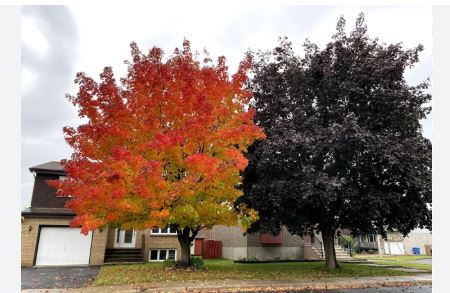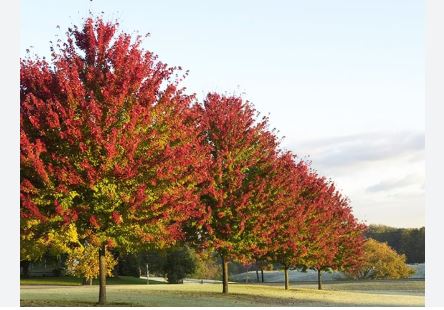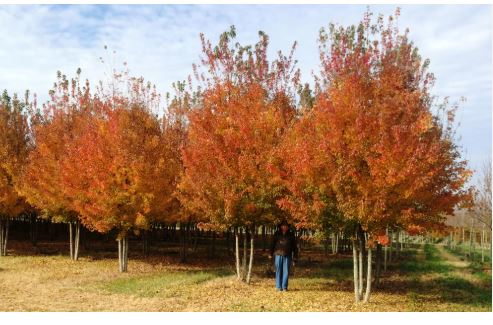
The Trident Maple (Acer buergerianum), a charming deciduous tree native to East Asia, is prized for its compact size, vibrant fall foliage, and adaptability, making it a versatile choice for urban gardens, bonsai artistry, and ornamental landscapes. Known for its distinctive three-lobed leaves and exfoliating bark, this small maple offers year-round beauty and resilience, thriving in diverse conditions where larger maples might struggle.
Its cultural significance in Asian horticulture and growing popularity worldwide highlight its appeal. In this detailed guide, we explore the botanical classification, history and native area, identifying characteristics, habitat, distribution, USDA hardiness zones, uses, and fascinating facts about the Trident Maple.
Botanical Classification, History and Native Area
The Trident Maple, scientifically named Acer buergerianum, belongs to the Sapindaceae family, which includes maples, horse chestnuts, and lychees. The genus Acer encompasses over 150 maple species, with Acer buergerianum classified in the section Platanoidea, alongside species like the Norway Maple (Acer platanoides). The species name buergerianum honors Heinrich Buerger, a 19th-century German botanist who studied Asian flora.
As an angiosperm, it produces flowers and seeds, with a typically monoecious reproductive system, bearing male and female flowers on the same tree. Its taxonomic relatives include the Japanese Maple (Acer palmatum) and Amur Maple (Acer ginnala), but the Trident Maple’s unique three-lobed leaves and small stature set it apart, earning it a distinct place in horticulture and bonsai.
The Trident Maple is native to East Asia, specifically eastern China, Taiwan, and southern Japan, where it grows in temperate forests and rocky hillsides. Its cultivation in Asia dates back centuries, particularly in China and Japan, where it was valued for its compact form and vibrant foliage, making it a staple in traditional gardens and early bonsai practices.
Introduced to the West in the late 19th century through botanical expeditions, it gained popularity in Europe and North America for its urban tolerance and ornamental appeal. In Japan, it is known as miyama kaede or “mountain maple,” reflecting its natural habitat. The tree’s adaptability and aesthetic qualities have led to its global cultivation, though its native populations face pressures from urbanization and habitat loss in parts of China, underscoring the importance of conservation efforts.
Identifying Characteristics

The Trident Maple is a small to medium deciduous tree, typically growing 15–25 feet (4.5–7.6 meters) tall and wide, with a rounded to spreading canopy and a low, branching habit. Its bark is smooth and grayish-brown when young, developing an attractive, exfoliating texture with age, revealing patches of orange, brown, and gray, adding winter interest.
Leaves are opposite, simple, and distinctively three-lobed (1–3 inches wide), resembling a trident, with glossy dark green surfaces and serrated margins, turning brilliant shades of yellow, orange, red, or purple in fall. The tree produces small, yellowish-green flowers in spring, followed by paired samaras (winged seeds, 0.5–1 inch long) with divergent wings. Twigs are slender, reddish-brown, with small, pointed buds, and the tree’s compact, dense structure enhances its ornamental and bonsai potential.
Habitat
The Trident Maple thrives in temperate environments, preferring well-drained, fertile soils with a slightly acidic to neutral pH (5.5–7.0), such as loam or sandy loam, though it tolerates clay and poor soils better than many maples. It grows best in full sun to partial shade, requiring at least 4–6 hours of sunlight daily for optimal foliage color and growth.
In its native range, it occurs in mixed forests, rocky slopes, and streamside habitats, adapting to varied conditions from moist valleys to drier uplands. In cultivation, it excels in urban gardens, patios, streetscapes, and containers, tolerating pollution, compacted soils, and moderate drought once established. However, it is sensitive to waterlogged soils and salt, requiring careful site selection to prevent root rot and ensure vibrant seasonal displays.
Distribution
The Trident Maple is native to eastern China (e.g., Jiangsu, Zhejiang, Anhui), Taiwan, and southern Japan, where it grows in temperate forest ecosystems. Since its introduction to the West in the 1890s, it has been widely cultivated in temperate regions globally, including North America (e.g., United States, Canada), Europe (e.g., UK, Germany), Australia, and New Zealand. In the U.S., it is popular in states like California, Oregon, New York, and Georgia, where its small size and urban tolerance suit diverse landscapes.
Available through nurseries like FastGrowingTrees.com and Monrovia.com, its distribution is driven by demand for ornamental trees and bonsai stock. While it can produce seedlings in favorable conditions, it is not considered invasive, as its germination rates are low outside cultivated settings.
USDA Hardiness Zones
The Trident Maple thrives in USDA Hardiness Zones 5–9, tolerating minimum temperatures from -20°F to 20°F (-29°C to -7°C). It excels in temperate climates with cold winters to break dormancy and warm summers to support growth, making it ideal for regions from the Northeast to the Southeast U.S.
In Zone 5, it withstands cold with mulching and wind protection, while in Zone 9, it tolerates heat and humidity with irrigation and afternoon shade to prevent leaf scorch. Its broad hardiness range and urban adaptability make it suitable for diverse landscapes, from coastal gardens to inland cities, provided soil drainage and sunlight needs are met.
Uses
The Trident Maple is primarily an ornamental tree, valued for its compact size, vibrant fall foliage, and exfoliating bark, making it ideal for small gardens, courtyards, patios, and urban streetscapes. Its low, branching habit and dense canopy provide light shade, enhancing outdoor spaces, while its seasonal colors—spring green, summer bronze, and fall reds—add year-round interest.
It is a premier choice for bonsai, prized for its small leaves, trainable branches, and textured bark, creating miniature masterpieces in Japanese and Western traditions. Ecologically, its flowers attract pollinators like bees, and its seeds feed birds, though its small stature limits wildlife habitat compared to larger trees.
The wood, though not commercially significant, is occasionally used for small crafts. In urban settings, it mitigates heat, improves air quality, and softens hardscapes, though its maintenance needs (e.g., pruning, pest control) require planning. Culturally, it evokes Asian garden aesthetics, symbolizing resilience and balance.
Fun Facts
The Trident Maple is rich with intriguing facts that highlight its unique appeal. Its three-lobed leaves, resembling a trident, inspired its common name and make it instantly recognizable among maples. In bonsai, it is a favorite for its ability to develop a thick trunk and intricate branches in just a few years, earning it the nickname “bonsai superstar.”
Its exfoliating bark, peeling to reveal a patchwork of colors, is often compared to the Paperbark Maple (Acer griseum), adding winter allure. In China, ancient specimens are revered in temple gardens, symbolizing longevity. The tree’s fall foliage can vary by climate, with cooler regions producing fiery reds and warmer areas yielding oranges, offering a tailored show.
Its urban tolerance, surviving pollution and compacted soils, makes it a go-to for city planners. Finally, a famous Trident Maple bonsai, displayed at the U.S. National Arboretum, is over 50 years old, showcasing the species’ potential for miniature artistry.
Cultivation of Trident Maple (Acer buergerianum)

Cultivating the Trident Maple (Acer buergerianum), a versatile and attractive deciduous tree native to East Asia, is a rewarding endeavor for gardeners, landscapers, and bonsai enthusiasts seeking a compact tree with vibrant fall foliage, exfoliating bark, and urban adaptability.
Renowned for its distinctive three-lobed leaves and suitability for small gardens, streetscapes, or bonsai, this tree thrives in temperate climates, offering year-round beauty but requiring careful management to optimize its growth, color, and health.
- Climate Suitability: Trident Maple thrives in USDA Hardiness Zones 5–9, tolerating minimum temperatures from -20°F to 20°F (-29°C to -7°C). It excels in temperate climates with cold winters to break dormancy and warm summers to support growth. In Zone 9, provide irrigation and afternoon shade during hot summers to prevent leaf scorch, while in Zone 5, protect against harsh winter winds to ensure survival.
- Site Selection: Choose a location with full sun to partial shade, receiving at least 4–6 hours of direct sunlight daily, to promote vibrant foliage and robust growth. Full sun enhances fall color intensity, though light shade is tolerated in hotter climates. Ensure the site accommodates its mature size (15–25 feet tall and wide) and avoid planting near pavement or utilities, as its roots may cause minor disruption in confined spaces.
- Soil Requirements: Plant in well-drained, fertile soil with a slightly acidic to neutral pH (5.5–7.0), preferably loamy or sandy loam, to support healthy growth and coloration. The tree tolerates clay and poor soils better than many maples but is sensitive to waterlogged conditions, which cause root rot. Test soil drainage and amend with organic matter (e.g., compost, peat moss) to enhance fertility, aeration, and moisture retention without saturation.
- Planting Time: The optimal planting seasons are early spring or fall, allowing roots to establish before summer heat or winter cold. Dig a hole twice as wide and as deep as the root ball, positioning the root collar at or slightly above ground level to prevent rot. Backfill with a mix of native soil and compost, tamp gently, and water deeply to settle the roots and eliminate air pockets.
- Watering Needs: Water young trees deeply (1–2 times weekly) for the first 1–2 years to establish a strong root system, keeping soil consistently moist but not soggy. Once established, the tree is moderately drought-tolerant and urban-tolerant, requiring supplemental watering during prolonged dry spells, especially in warmer zones or city settings, to maintain foliage health and fall color vibrancy. Use drip irrigation to minimize fungal risks.
- Mulching: Apply a 2–3 inch layer of organic mulch (e.g., shredded bark, wood chips) around the base, extending to the drip line but keeping it 2–4 inches from the trunk to prevent rot and pest issues. Mulch conserves moisture, regulates soil temperature, and protects shallow roots, supporting young trees in gardens, streetscapes, or containers. Replenish mulch annually to maintain its benefits.
- Fertilization: Fertilize young trees in early spring with a balanced, slow-release fertilizer (e.g., 10-10-10 or 5-10-5) to promote steady growth and vibrant foliage, applying at half the recommended rate to avoid excessive vegetative growth that weakens structure. Mature trees need minimal fertilization in fertile soils, but a light application every 2–3 years can enhance color and vigor. Avoid high-nitrogen fertilizers, which may reduce fall coloration and increase pest susceptibility.
- Pruning: Prune in late winter or early spring, when the tree is dormant, to remove dead, damaged, or crossing branches and to shape its rounded canopy, using clean, sharp tools to prevent disease spread. Light pruning enhances airflow and light penetration, critical for foliage health and bonsai training, but avoid heavy cuts, as maples are prone to fungal infections. For bonsai, regular pruning and wiring shape its compact form, maintaining miniature aesthetics.
- Pest and Disease Management: Monitor for pests like aphids, scale, or Japanese beetles, treating infestations with insecticidal soap or neem oil. The tree is susceptible to fungal diseases such as verticillium wilt, anthracnose, and powdery mildew, especially in humid or poorly drained conditions; ensure good drainage, improve air circulation, and remove infected debris promptly. Apply fungicides preventatively in high-risk areas, and avoid wounding the bark to minimize infection risks.
- Spacing: Space trees 15–25 feet apart to accommodate their mature canopy spread, ensuring adequate sunlight and air circulation to promote foliage health and reduce disease risk. For streetscapes or group plantings, plant 10–15 feet apart for a cohesive canopy. For bonsai or container gardening, a single tree suffices, with spacing irrelevant. Consider their height (up to 25 feet) when planning near structures or pathways to avoid conflicts.
- Wind Protection: Young Trident Maples, with shallow to moderate roots, are moderately wind-tolerant but may need support in exposed urban or coastal sites. Plant in sheltered locations or use windbreaks (e.g., fences, shrubs) to protect foliage and branches. Stake newly planted trees for the first 1–2 years using flexible ties to allow slight trunk movement, strengthening roots, and remove stakes once established to prevent girdling.
- Winter Care: In Zone 5, protect young trees from winter damage by wrapping trunks with burlap or tree guards to prevent sunscald, frost cracks, and rodent damage, and mulching heavily (3–4 inches) around the base to insulate roots. For container or bonsai trees, move to sheltered areas or wrap pots to protect roots from freezing. Water adequately before freeze-up to prevent dehydration. Mature trees are cold-hardy and require minimal winter care in temperate climates.
- Long-Term Growth: Trident Maples grow moderately fast (1–2 feet per year), reaching 15–25 feet at maturity, with lifespans of 50–100 years in optimal conditions, longer in bonsai with meticulous care. Their vibrant fall foliage, exfoliating bark, and compact form make them ideal for small gardens, urban settings, or bonsai artistry. Regular monitoring for pests, diseases, and structural health, combined with attentive care, ensures lasting beauty and resilience, whether as a landscape tree or miniature masterpiece.